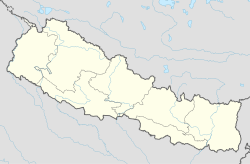Sworgadwari (स्वर्गद्वारी pronounced [swʌrɡʌdwaɾi]) is a hilltop temple and pilgrimage site in Pyuthan District, Nepal, commemorating the special role of cows in Hinduism. It is said to have been founded by Guru Maharaj Narayan Gautam Khatri (Swami Hamsananda), who spent most of his life in the vicinity herding and milking thousands of cows.[1][2] According to traditional stories, some of his devotees followed him to see where he took the cows, but they could never find him. According to older people in the locality, he came from Rolpa to the present temple site and asked the owner of that land (the landlord) to donate the land to him. He dug the land and obtained curd mixed rice and fire. He had explained that these things were those buried by the Pandavas in Dvapara Yuga, when they worshipped in this place before departing to heaven. The landlord was astonished. He agreed to hand over the land instantly. Thereafter the holy fire burns continuously until then. The Bivut (ash) of the firewood burnt by the holy fire is believed to cure different physical disorders like headaches and stomach aches.
| Sworgadwari / Swargadwari | |
|---|---|
स्वर्गद्वारी | |
 | |
| Religion | |
| Affiliation | Hinduism |
| District | Pyuthan District |
| Deity | Lord Narayan or Bishnu, Lord Shiva |
| Festivals | Baisakh, Kartik Purnima |
| Location | |
| Location | Mahabharat Range |
| State | Rapti Zone |
| Country | Nepal |
| Geographic coordinates | 28°7′16.68″N 82°40′24.55″E / 28.1213000°N 82.6734861°E |
| Architecture | |
| Date established | 1941 (1998 B.S.) |
| Elevation | 2,100 m (6,890 ft) |
Before he left his physical body the guru gave some of his powers to a few disciples. On the day he departed his physical body by his own will, a number of people gathered around him at the place where he habitually meditated. The guru left his body after bidding goodbye to his disciples and other followers. His favourite cow also died at the same instant, and then the rest of the cows miraculously disappeared within a few days. There are also accounts of cows emptying their milk by themselves every day at the same time, at the place where the Guru died. He had done many miracles during his lifetime. Once he asked Rolpali cowherds not to take the cattle to graze in a particular area warning them of a huge landslide there. But they refused and were swept away by the landslide. He used to tell the fortunes of the devotees. He was so kind that no one returned from the temple without food. He helped the poor build their houses. He managed to teach Vedic scriptures and other religious scriptures to the children. They may perform Vedic worship in the temple after studying. But doing this is not a compulsion.
Swargadwari is counted among Nepal's top pilgrimage sites[3][4] and is listed in a national inventory of cultural and historic heritage sites.[5]
As of 2009, a cable car to the temple complex was under construction.[6] In the aftermath of the 1996-2006 Nepalese Civil War, donations of straw and hay had diminished to a point where resident cattle at Swargawari were in danger of starving.[7][8]
It is one of the most popular Hindu places. It is located in the southern part of Pyuthan district. The main visitors to this religious area are Nepalese and Indians. Swargadwari is also popular for trekking. It takes two days to reach there by foot. The footfall in Swargadwari increases dramatically in June and July. Anyone can reach there from two routes; from Bhingri, and from Ghorahi. It takes around 4 hours from Bhingri to reach Swargadwari, and around 8 hours from Ghorahi, Dang. But the routes are extremely breathtaking. The route from Dang is more dangerous in comparison to the Bhingri road. This road has been recently rerouted for betterment and a safe journey. It lies on the top of the hill, surrounded by pine forests. There are a vast number of Rhododendron trees on the way and in Swargadwari itself.
References
edit- ^ Yadav, Ram (2020-02-10). "SWARGADWARI, Pyuthan - Nepal Tourism Hub". Retrieved 2024-08-19.
- ^ INS, स्वतन्त्र समाचार सेवा / (2023-05-18). "धरतीको स्वर्ग अर्थात् स्वर्गद्वारी !". INS. Retrieved 2024-08-19.
- ^ "Sworgadwari Darshan". Kathmandu: Adventures Nepal. Retrieved April 10, 2011.
- ^ "Pilgrimage Tour Nepal". Kathmandu: Angel Tours and Trekking Operator Nepal. Retrieved April 10, 2011.
- ^ Bhandari, Bishnu, ed. (1997), Inventory of heritage sites in Nepal, Kathmandu: IUCN Nepal, Heritage and Biodiversity Conservation Programme., retrieved April 10, 2011
- ^ "Nepalese Government is planning to construct six more cable cars". Everest Journal. February 20, 2009. Retrieved April 10, 2011.
- ^ Bohara, Gajendra (January 4, 2010). "500 cows starving in Swargadwari". Republica. Nepal Republic Media, Pvt. Ltd. Retrieved April 7, 2011.
- ^ Bohara (January 10, 2010). "Straw collection for starving cows". Republica, op. cit.
External links
editMaps and Imagery
edit- Satellite Image of Temple Complex
- Terrain Swargadwari (temple icon), Dang Valley (D), Mahabharat Range (green line), Arun Khola (A), Madi Kh. (M), Jhimruk Kh. (J)
